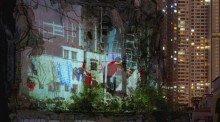The art of Tong Lam, an affiliate faculty member at the Munk School’s Asian Institute and an associate professor at University of Toronto, is featured this summer and fall at a solo exhibition mounted at Museum für Asiatische Kunst, one of Berlin’s state museums.
The exhibition, “Global Images in Motion”: Chinese painting of the 20th century and contemporary photographs by Tong Lam”, is curated by Uta Rahman-Steinert.
While the desire for a better future lives on in China, some dreams imagined in the early days of the People’s Republic have “fallen by the wayside”, says Rahman-Steinert, and Lam captures this in his haunting photographs. “His documentation of the surreal landscape of Xian Cun, a doomed area within Guangzhou’s (or Canton’s) new CBD, offers a glimpse of the precarious lives of the district’s inhabitants, whose futures in the face of progress look bleak. The settlement is one of the many enclaves of collective property, left over from the communist collectivization of land. Surrounded on all sides and soon to be engulfed by the feverish expansion of the Chinese mega-city, it has been left to decay so that its inhabitants will eventually have no option but to succumb to the city’s relentless urban regeneration policy.”
Although Lam has had solo exhibitions at various university galleries before, “this is the most exciting venue yet,” he says. “In part, this is because the exhibition uses an innovative approach to juxtapose two groups of images that are not normally shown together. Specifically, my photographs of post-socialist Chinese cities are in dialogue with traditional-style Chinese landscape paintings from the 1960s that try to capture images of early socialist modernity. In doing so, the exhibition explores some very important and timely issues, meaning the changing visions of modernity and urban transformation in China today. It is a provocative contrast of visions, landscapes, and media forms.” Some of the photos are printed while others are displayed via light boxes.
Lam says he is someone who works at the intersection of two worlds: academic and art. “I’m always keen on bringing art to scholarship and vice versa. I think this exhibition provides an opportunity to do precisely that. And since this is a major public museum, it also allows me to reach a large general audience.”
The exhibitions runs until Oct. 18, 2015.
